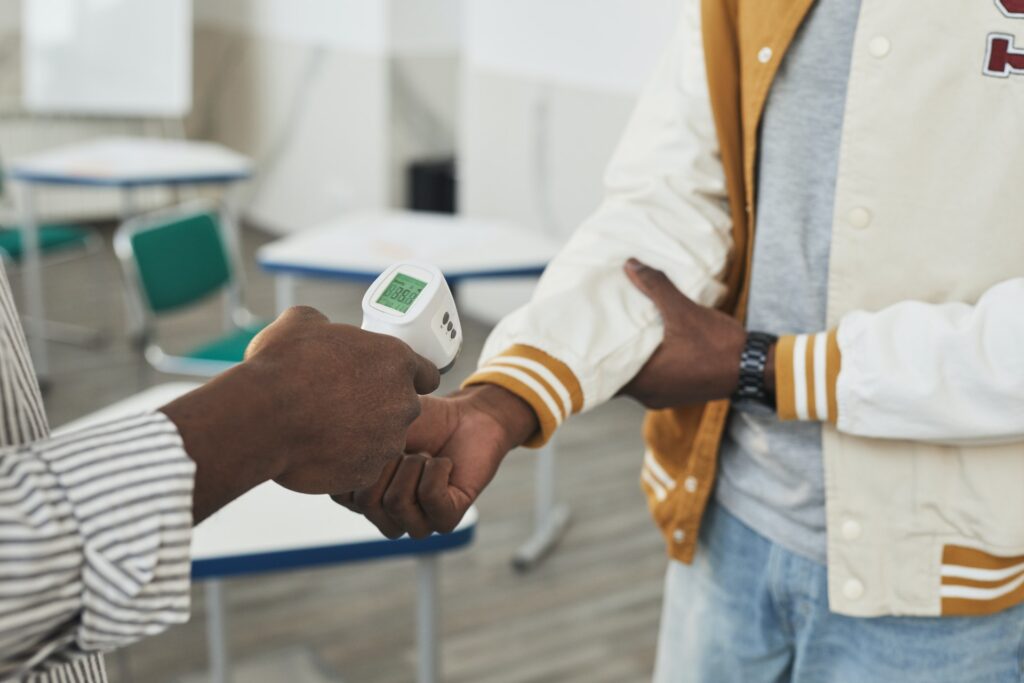Managing fever in children is one of the major concerns of parents and caregivers because of how often kids get fever.
Your child who has been feeling alright all day long suddenly wakes up at night with chills and shivers. You may not be sure on what to do next; whether to give drugs or to call the doctor.
Fever is one of the body’s ways of fighting off infections such as cold, cough and malaria. It is a rise in body temperature above the normal.
This article sheds light on what a fever entails and also debunks some myths about fever.
What is a fever?
Fever occurs when the body temperature rises above the normal. In children, the average body temperature ranges from 36.6 to 37.2°C (97.9 to 99°F). Hence, it is considered a fever above 37.2°C.
It is normal for the body temperature to slightly rise at night because of the variation in temperature throughout the day. Hence, the normal range of temperature.
A rectal thermometer is the most accurate method of checking a child’s temperature. It is inserted into the child’s anus to measure the temperature reading. Other types of thermometers used are oral, armpit, ear and forehead thermometers.
In addition to checking your child’s temperature with a thermometer, there are other signs and symptoms that help to tell if your child has a fever. They include:
- Feeling warm or hot
- Fatigue
- Lip blisters
- No interest in playing
- Feeling irritable
- Loss of appetite
- Headache
- Body aches
- Excessive sleepiness or having trouble sleeping
- Crying
- Sweating
- Chills and shivering
- Dehydration
Types of fever
There are two broad types of fever:
Acute fever
It normally occurs suddenly and lasts for a short period of time. It is caused by an infection such as respiratory infections including colds and flus due to viral and bacterial infections.It is also caused by malaria parasite infestation.
Chronic fever
It usually develops over a prolonged period of time. Some of the causes include; prolonged viral infections, recurring viral infections, pneumonia, sinusitis which includes stuffy nose.
Low-grade fever
A third type of fever is referred to as low-grade fever and here, the body temperature rises slightly above the normal temperature range, between 37.5°C and 38.3°C. Hence, it is a very mild type of fever that resolves within a few hours.
Causes of fever in children
As earlier mentioned, fever in itself is not a problem but can be as a result of an ailment. It might be caused by:
- Viral infections such as common cold, flu, respiratory infections, and gastroenteritis.
- Bacterial infections like ear infections, sinus infections which includes stuffy nose or catarrh.
- Immunization: It involves the introduction of a vaccine into a child’s system to help fight against diseases. The body initially responds to it as a foreigner, which then triggers it to develop a fever. Fever following immunization is usually a low grade one. Common examples of vaccines taken by children are: Measles vaccine and the DTP vaccine, which vaccinates against diphtheria, tetanus and pertussis also known as whooping cough.
- Cancer such as leukemia and lymphoma.
- Other infections such as malaria, which is caused by plasmodium parasites and is common in the tropics.
Some myths associated with fever in children
Myth #1: Administering “fever medicines” to your child the moment you feel that their body is warm.
Fact: Remember, fever is not necessarily the bad guy so, it is not advisable to always administer fever drugs to your child. Doctors usually administer meds when the child’s temperature is over 40°C (104F) and of course, they know the suitable drug and dosage to prescribe. Hence, it’s always right to consult your doctor before using any medication.
Myth #2: All fever require medical attention
Fact: Fevers often go on their own, within 2 to 3 days. Rather than focusing only on your child’s fever, monitor them for other signs. If you observe signs such as vomiting and stooling, cough and sore throat accompanying the fever or the fever lasts more than 3 days, call your doctor.
Myth #3: “I touched my child’s forehead and it’s hot, so it’s definitely a fever”
Fact: Feeling your child’s body doesn’t suffice in telling if they have a fever or not. A child’s body can be hot for other reasons, thus it’s best you confirm whether or not they have a fever, using a thermometer.
Myth#4: Teething is a common cause of fever.
Fact: According to the American Academy of Pediatrics, even though teething might slightly increase the body temperature of your kid, it is not considered enough to cause a fever.
Myth #5: If you “can’t break” the fever, then the cause is serious.
Fact: That a fever doesn’t come down even after treatment doesn’t determine the severity of the cause. How long the fever lasts, cannot tell us whether it’s been caused by a virus or bacteria. What truly matters is how your child looks.
Myth #6: A high fever will cause brain damage.
Fact: A high fever will not cause brain damage. However, it can lead to febrile seizure, which refers to convulsion in kids due to a sudden rise in temperature. It usually occurs during the first few hours of a fever, and it may also be the first sign to notice before you even know your child is ill.
A child experiencing febrile seizure may look strange for a few moments, then stiffen, twitch and roll their eyes. They also experience disturbed breathing and their skin may appear bluish.
However, febrile seizure is not as frightening as it sounds, it usually lasts for a few minutes and stops on its own. It is not epilepsy or related to any cognitive disorder so, it will not lead to a brain damage.

What can I do to help my child’s fever?
Fever is a very common occurrence in children. You cannot prevent your child from having a fever by even administering drugs. Kids will come down with a fever at one point in time or the other.
However, there are some home remedies for fever that can be helpful. They include:
- Ensure your child stays hydrated: Fever can cause dehydration, you can checkmate this by giving them water, milk, pepper soup, fruits such as water melon or fresh fruit juices, and rehydrating drinks such as oral rehydration solutions (ORS).
- You can bring down your child’s temperature slightly by giving them a warm water bath.
- Avoid over-wrapping your child, cover them up moderately. Over-wrapping them can further increase their body temperature
- Avoid old practices like rubbing a child’s body down with alcohol. Alcohol can be absorbed into the skin and become harmful.
Before we call it a wrap…
Do not hesitate to seek medical attention if your child presents with any of the following:
- If your baby is less than 3 months old.
- If your baby appears very weak or sick, and continues to cry non-stop.
- If your child shows signs of dehydration including, sunken eyes, dry lips, little or no urination.
- If your child has been to the doctor before but there are still no improvements.
- If their temperature is above 40°C.
- If they begin to experience shortness of breath.
- Call in for an emergency if your newborn baby has a fever or if they develop a febrile seizure for the first time.
The Gist
As common as fevers are in children, they can only be remedied and not prevented. Fever is a way your child’s body fights off infection and so, it is a symptom of a problem not the problem itself.
It is important you learn the truths about fever because of the many wrong practices associated with it. One of such practices is giving fever medicines to your children without the doctor’s prescription, which can be pretty risky.
One good thing to note is that how your child looks and acts when they have a fever is more important than the exact temperature.
Finally, always remember the doctor is your surest bet. You worried about your child’s fever? The fever seems beyond your control? Call the doctor right away!


